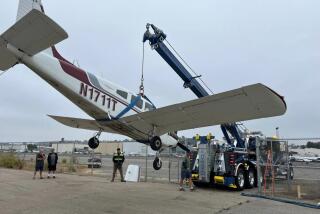Plane in deadly Montana crash may have had fuel problems
Reporting from Seattle â A plane that crashed in Montana last year carrying three California families to a ski trip may have experienced fuel problems before it diverted and plummeted into in a cemetery near the Butte airport, according to documents released Friday by the National Transportation Safety Board.
The cause of the March 2009 crash that killed 14 â including doctors, dentists and their children â has been a mystery. While the NTSB has not released any conclusions, the documents shed new light on the accident and suggest a cascading series of events triggered by cold weather, the pilotâs failure to add ice inhibitors to the fuel, dicey visibility and possibly a deadly low-altitude stall as the plane came in for landing.
NTSB officials have not said when they will release their findings.
Although it may not have contributed to the crash, the documents confirm that the pilot, Ellison âBudâ Summerfield boarded 13 passengers, four more than the plane was certified to carry. The Pilatus PC-12 aircraft departed on the final leg of the flight 572 pounds over its maximum recommended gross weight.
Moreover, in flight plans filed with the Federal Aviation Administration, Summerfield twice underreported the number of passengers on board during the trip from Redlands to Vacaville, Oroville and on toward Montana. Along the way he picked up six adults and seven children.
However, enough fuel had burned off en route that the plane was under its maximum weight by the time it diverted from its destination of Bozeman, Mont., to the crash site at Butte, Mont., the documents show.
The co-owner of the plane, Irving M. âBudâ Feldkamp III, owner of a string of dental clinics in Southern California, was planning to drive to the exclusive Yellowstone Club in Montana to meet his two daughters and their families, who were aboard the plane, most of them medical professionals from California.
Feldkampâs daughter Amy Jacobson, 34, of St. Helena, Calif., died along with her husband, Erin Jacobson, 36, and their children, Taylor, 4, Ava, 3, and Jude, almost 2. His other daughter, Vanessa Pullen, 37, of Lodi, was killed with her husband, Michael Pullen, 39, and their children, Sydney, 9, and Christopher, 7; The dead also included Brent Ching, 37, and his wife, Kristen Ching, 31, of Durham, and their children, Hailey, 5, and Caleb, almost 4. Summerfield, 65, also perished in the crash.
The NTSB reported that Summerfield had fueled the plane the day before it left Redlands but had not requested an anti-icing additive, as the manufacturer recommends in operations below freezing.
Another plane in the Butte area had reported icing conditions, which can not only build up on wings and impair flight, but can block delivery of fuel to the engines if water in the fuel freezes in flight.
One of the central questions of the investigation has been why Summerfield, a little more than half an hour before the plane would have landed in Bozeman, contacted air traffic controllers and requested clearance to divert to nearby Butte.
The reports say it is âof particular interestâ that both fuel boost pumps had started cycling on and off on the initial leg of the flight from Redlands. On the final leg, the pumps again began cycling and one remained on. A low-fuel caution light came on, indicating only about 20 gallons of fuel remaining in the right tank.
Summerfield requested permission to descend to a lower altitude â a likely response to such a scenario â and land at Butte. He reported no technical problems and assured controllers he had the airport in sight after clearing a cloud.
Witnesses on the ground, however, told investigators that the plane emerged from the clouds on an abnormal approach path for the runway, and too high to land. The plane entered a steep turn and then plunged nose first into the ground, they said.
The risk of steep turns at slow speeds is that the aircraft wings can lose their lift and stall â a scenario that former NTSB investigator Alan Yurman, now a private aviation consultant, thinks is possible.
Significantly, Yurman said, the reports show that the warning light on the Pilatusâ anti-stall system, which automatically tries to push the aircraftâs nose sharply downward to avert a stall, activated three times in the moments before the crash even though the pusher system did appear to have activated.
More to Read
Sign up for Essential California
The most important California stories and recommendations in your inbox every morning.
You may occasionally receive promotional content from the Los Angeles Times.










